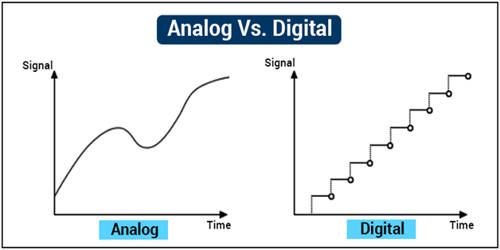Digital as well as Analog System, both are used to transmit signals from one place to another like audio/video. Digital system uses binary format as 0 and 1 whereas analog system uses electronic pulses with varying magnitude to send data. Which one is better between analogue and digital signal can be measured by three factors. These are:
- the qualitative standard of the sipial,
- the elements to maintain the process and
- cost or expense.
A method of storing, processing and transmitting information through the use of distinct electronic or optical pulses that represent the binary digit 0 and 1. A Digital signal is the best to send a signal to a long distance. If the distance is long, the power of analogue signal decreases gradually. Then to sustain the analog signal, amplification has to be done. As a result noise increases, and the quality of the signal is reduced or distorted and it can be fully lost. Analog is a transmission standard that uses electrical impulses to emulate the audio waves of sound. When you use a phone, the variations in your voice are transformed down the line to the exchange.
But the digital signal is amplified on the way. As a result, the signal remains unchanged. Digital signal is used to transmit a signal through an optical fiber since the qualitative standard of the last signal remains unchanged. Besides many signal can be sent in every second. Though the digital device is more expensive than the analogue device, the total cost is less in the digital system than that of the analogue system. Cross-connection may have occurred in analogue device but it cannot happen in the digital system.
A thorough understanding of analog and digital technologies is developed through an analysis of the advantages and disadvantages of each. The technologies are used throughout the world and the infrastructure varies, so a varied approach to applying the technology will depend on that infrastructure and the standards that apply to the region for which the systems are being installed.
Advantages of Digital System:
- Less expensive, easy to implement.
- More reliable, you can save your data and retrieve it when needed.
- Easy to manipulate.
- Flexibility with system change, use of standardized receiver and Transmitter.
- Compatibility with other digital system.
- Integrated networks.
Disadvantages of Digital System:
- Sampling Error, sampling error is most common in many cases.
- Not wide bandwidth.
- Ambient weather Dependencies are high.
- Digital communications require greater bandwidth
- The detection of digital signals requires the communications system to be synchronized.
- Low life span as more Dependencies on outer source.
Advantages of Analog System:
- Uses less bandwidth
- More accurate
- Flexibility with bandwidth.
- Great lifespan and, ambient weather dependencies are low.
- Easy to handle not expensive, over-sensitive routings.
Disadvantages of Analog System:
- High cost of signal conversion inside the display
- Upgrade to digital interface not possible.
- No security for transmission data.
- Needed perfect receiver and Transmitter for specific communication scenario. If you move into a new system and you want to change the analog signal you need to tune or change both reciver and Transmitter.













